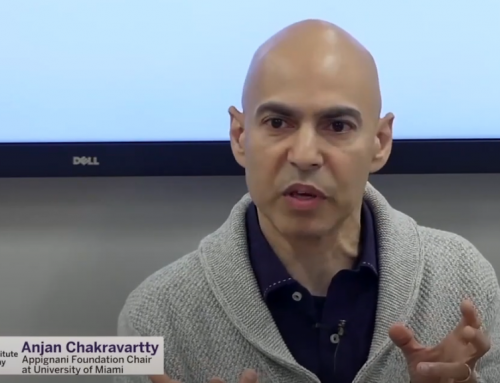By Frédéric-I. Banville
On May 1st 2013, Professor Alfonso Caramazza (Harvard University) gave the second lecture in the Neurophilosophy Speaker Series, which is jointly sponsored by Western’s Rotman Institute of Philosophy and the Brain and Mind Institute. Caramazza is a professor of Psychology, Director of the Cognitive Neuroscience Laboratory at Harvard University and the Directory of the Center for Mind/Brain Sciences at the University of Trento in Italy. While he may not identify himself as a philosopher, it was exciting to hear a working scientist engage with some tough philosophical questions relating to his field. His talk identified several points of contact between philosophy and neuroscience.
Caramazza’s talk, titled “Levels of Representation in the Mind/Brain: What good are sensory-motor representations?”, was aimed at the role of representations in the mind/brain sciences. He raised several pressing concerns with a view he called “embodied cognition”. The research program he was concerned about emphasized the role of sensory-motor systems, and in particular sensory-motor representations, in retrieval of semantic knowledge. He raises challenges for views of embodied cognition which claim that this process (of semantic retrieval) requires the brain to simulate, or re-enact stored memories in order to access modality-specific information. It should be noted that “embodied cognition” – as we use it here – refers to the view Caramazza discussed (outlined above), and not to the family of philosophical theories that go by the same name. These theories, while interesting in their own right, advance theses that, while somewhat related to the view Caramazza argues against, are importantly different.
By considering several experiments Caramazza aimed to intuitively establish that we don’t really know what perception means or what concepts are, let alone have evidence for the claim that concepts can be reduced to sensory-motor representations. That claim is based on evidence from behavioural tasks and neurophysiological data that shows sensory-motor areas of the brain are active during semantic retrieval. Caramazza argued that these studies do not provide an indication of the direction of the effect observed. It is unclear if the interaction is the result of representing concepts via the sensory-motor system or the result of a conceptual representation influencing the perception and motor processing of the brain. Essentially, if the brain is engaged in the representation of semantic information, then we have not yet answered how it does so and, more importantly, where that representation occurs in the brain.
There is no evidence that the motor cortex processes semantic information, as activation during behavioural tasks is inconclusive. The real problem here, Caramazza argued, is that we do not know what ‘perception’ or ‘concept’ means, and yet theories of embodied cognition invoke these notions and trade on their ambiguity. To illustrate this kind of reasoning he appealed to the notion of ‘visual neurons’, which are defined as neurons in the visual cortex. Of course, this definition does not satisfactorily answer the question ‘what are visual neurons?’, since the only requirement they have to meet, outside of being located in an area that is involved in visual processing, is that they have historically been involved in visual processing (in the sense of being active during visual processing). Assuming the importance of network-level coupling of functional areas for semantic processing, which is supported by some of the results discussed, historical involvement is not a sufficient requirement for cells to be functionally specialized in the way the type of embodied view he argues against require them to be.
In sum, there is a serious problem with attempting to reduce conceptual representations and semantic processing to sensory-motor processes: it ignores the high level of connectivity involved in higher-level cognitive processing.
It is interesting that Caramazza’s talk highlights this issue, as it converges with very current concerns in the philosophy of neuroscience. Understanding what good explanations in neuroscience are like is a current and popular project in the field. Recently some philosophers have proposed that explanation in neuroscience is mechanistic. That is, neuroscientists are not looking for general laws, but rather for the mechanisms responsible for the phenomena they wish to explain. Such an approach is rather common in biology, and recently philosophers such as William Bechtel (2008) and Carl Craver (2009; see also Machamer, Darden & Craver, 2000) have offered detailed accounts of how mechanistic explanation proceeds in neuroscience. This topic is of particular interest as mechanistic explanation was the focus of a graduate seminar in philosophy of neuroscience taught by Professor Jacqueline Sullivan this winter.
One advantage of thinking about explanation this way is that it emphasizes the fact that neuroscientists must delineate the phenomena they are interested in and, crucially, must, make certain simplifying assumptions about their object of study. The brain is immensely complex, and so it has to be “broken down”. This has been done in numerous ways, from identifying differences in the cellular composition of the different cortical areas so as to provide a “map” of the brain (Brodmann, 1909) to focusing on the functional specialization of certain areas. Obviously, different disciplines will use different ways of decomposing the brain. Neurobiology studies cells and cell networks, while cognitive neuroscience, which sits at the intersection of psychology an
d neuroscience, is concerned with higher-level structures, often specific cortical areas involved in cognitive processes such as visual perception and semantic processing.
The mapping of the brain by functional areas is difficult to do, because some anatomical regions may be involved in different cognitive processes or may even be performing only part of the process of interest. For example, when Pierre Paul Broca noticed, in 1863, that two of his patients had lost the ability to speak after suffering lesions to the inferior frontal gyrus of the brain, he hypothesized that the faculty of language was localized in that area. Since then, we have learned that what has come to be known as Broca’s area was in fact (largely) responsible for speech-related motor functions, and that language comprehension occurred in other parts of the brain located in the temporal lobe — although Broca’s area is also involved. This example shows, first, that localization of functions to any one specific part of the cerebral cortex is rarely, if ever, correct and that oftentimes the processes we are interested in are carried out by a network of areas rather than a single area.
Nevertheless, there is still, as Caramazza’s talk indicates, a tendency to infer the localization of a function when a given region is found to be heavily involved in carrying out the task of interest. Translating this into the vocabulary of mechanistic explanation we get the following: there is a tendency to treat areas of the brain as self-contained mechanisms responsible for a certain phenomenon. The reason for this may simply be that it has historically been beneficial to make such assumptions, and no doubt it will continue to be so. However, the sort of work that Caramazza presented, which undermines such assumptions, has a very important role to play.
From the perspective of mechanistic explanation, the problem that Caramazza identified with the embodied cognition view is that it fails to delineate the mechanism responsible for semantic processing correctly. The localization of some lower-level processes in fairly circumscribed cortical regions is well documented (an example of this is the localization of edge detection in the primary visual cortex). However, higher-level processing, involving multiple operations and, presumably, levels of processing are likely to be carried out by networks of areas, and in such cases it becomes difficult to figure out which area does what. In the case of semantic processing and conceptual representations, the fact that sensory-motor areas are involved along with the usual temporal lobe areas involved in language processing, does not (as Caramazza notes) necessarily suggest that semantic retrieval and conceptual processing are rooted in sensory-motor processes. It does, however, suggest that neuroscientists should be concerned with networks of areas rather than single areas. This is also something Caramazza insists on when discussing how pre-existing couplings between brain areas may influence the development of category-specific regions in the inferior temporal lobe, which is responsible for, among other things, category-based object identification (Mahon & Caramazza, 2011). The importance of network-level interactions is also emphasized by other researchers, such as Melvyn Goodale (who heads the Brain and Mind Institute at Western) and David Milner, who identified two functionally specialized streams that constitute, to put it simply, two visual systems (Goodale & Milner, 1995; 2005).
This implication of Caramazza’s work is very interesting. It suggests that neuroscientists should reconsider one of their basic assumptions regarding the adequate level of decomposition for the study of the brain. From the standpoint of mechanistic explanation, it is a real-world instance of researchers realizing that one of their assumptions was wrong and that their object of study was not decomposed appropriately. Decomposing the brain is a difficult task, and one of the main reasons for this is that it is not composed of self-contained mechanisms. Functional areas are in constant interaction, and while we may sometimes ignore this fact for reasons of simplification, decomposing the brain into networks rather than regions may yield interesting avenues for research.
In this sense, Caramazza’s talk was of particular interest philosophically. It is rare that the convergence between the interests of scientists and philosophers of science happens so clearly and easily.
Works Cited
Bechtel, W. (2008). Mental Mechanisms: Philosophical Perspectives on Cognitive Neuroscience. CRC Press.
Broca, P. P. (1863). Localisations des fonctions cérébrales. Siège de la faculté du langage articulé. Bulletin de la Société d’Anthropologie, 4, 200–208.
Brodmann, K. (1909). Vergleichende Lokalisationslehre der Grosshirnrinde in ihren Prinzipien dargestellt auf Grund des Zellenbaues. Leipzig: Johann Ambrosius Barth.
Craver, C. F. (2009). Explaining the Brain. OUP Oxford.
Goodale, M A, & Milner, A. D. (1992). Separate visual pathways for perception and action. Trends in neurosciences,15(1), 20–25.
Goodale, Melvyn A., & Milner, A. D. (2005). Sight Unseen: An Exploration of Conscious and Unconscious Vision (1st ed.). Oxford University Press, USA.
Machamer, P. K., Darden, L., & Craver, C. F. (2000). Thinking About Mechanisms. Philosophy Of Science, 67(1), 1–25.
Mahon, B. Z., & Caramazza, A. (2011). What drives the organization of object knowledge in the brain? Trends in Cognitive Sciences, 15(3), 97–103. doi:10.1016/j.tics.2011.01.004





